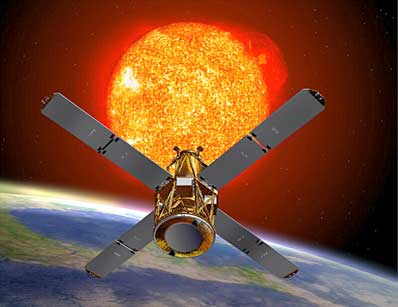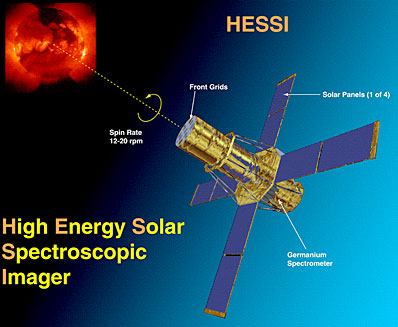
The HESSI spacecraft
FROM NASA PRESS KIT
Posted: February 3, 2002

An artist's drawing of HESSI. Photo: NASA
|
HESSI's sole instrument - an imaging spectrometer - will construct flare images from patterns of light and shadows that are produced by high-energy radiation as it passes through the telescope's grids while the spacecraft rotates. The spectrometer will separate the light electronically into its component ³colors,² which correspond to different wavelengths and energy levels. X-ray and gamma ray detectors onboard the spacecraft will count the number of photons passing through the grids and precisely measure their energy.
When combined with the imaging information, scientists can reconstruct high-resolution "color" pictures of solar flares using computers back on the ground. This advanced approach will significantly enhance our current understanding of the solar flare phenomenon.
HESSI measures 85 inches (2.16 meters) high by 227 inches (5.76 meters) wide after solar panel deployment. During launch, the spacecraft's solar panels are folded to 43.3 inches (1.1 meters) in width to fit securely inside the Pegasus rocket fairing.
Quick facts
- Spacecraft Weight - 645 lbs. (293 kg)
- Science Payload - X-ray and gamma-ray imaging spectrometer
- Onboard Memory - 4.0 gigabytes
- Spacecraft Telemetry - Up to 2 gigabytes/day
- Mission Lifetime - Two to three years
- Orbit - 373-mile (600-kilometer) circular orbit, inclined at 38 degrees to the equator.
- First Signal Acquisition - Should occur about 5 p.m. (93 minutes after the L-1011 aircraft is airborne).
- Mission Costs - Total mission costs are approximately $85 million for the spacecraft, instrument payload, launch vehicle, data analysis, ground operations and mission operations.
- Mission Oversight - HESSI is the sixth Small Explorer (SMEX) mission. The Explorers Program Office at Goddard provides management and technical oversight for the mission in accordance with NASA Headquarters Office of Space Science in Washington, D.C.
- Spacecraft and Instrument Design/Operation - The University of California, Berkeley (UC Berkeley), as principal investigator institution for this mission, is responsible for most aspects of the mission including the spacecraft and science payload, integration and environmental testing of the spacecraft, and operations and data analysis after launch. Development of the instrument was a joint effort by UC Berkeley, the Lawrence Berkeley
National Laboratory, NASA's Goddard Space Flight Center, and the Paul Scherrer Institut in
Switzerland. Spectrum Astro, Inc. of Athens, Ohio, built the spacecraft.
- Launch Operations - Kennedy Space Center is responsible for all launch operations at Cape
Canaveral Air Force Station, Fla.
- Payload Operations Centers - The mission and science operations centers for HESSI are
located at the UC Berkeley Space Science Laboratory.

Illustration of the HESSI spacecraft. Photo: NASA
|
HESSI science objectives
Solar flares, which occur in the atmosphere of the Sun, are the most powerful eruptions in our
solar system. During a flare, large numbers of electrically charged particles are rapidly
accelerated to high energies and gas is quickly heated to tens of millions of degrees.
Studying solar flares is important as they are often accompanied by coronal mass ejections, the
eruption of gas and energetic particles from the Sun. The energetic particles are particularly
dangerous to spacecraft that leave the protection of the Earth's magnetic field.
X-rays from flares also can alter the structure of the Earth's electrically charged upper
atmosphere, or ionosphere, and adversely affect radio communications, which rely on reflection
by the ionosphere for transmissions to distant receivers.
This mission will tell scientists where in the solar atmosphere these particles are accelerated,
when in the flare explosion the particle acceleration occurs, and what energies are achieved by
the accelerated particles. Data provided by HESSI will vastly advance our current
understanding of the fundamental high-energy processes that produce solar flares.

|
 |
 |
 |
Flight data file
Vehicle: Pegasus XL
Payload: HESSI
Launch date: Feb. 5, 2002
Launch window: 3:21-5:21 p.m. EST (2021-2221 GMT)
Mission staging site: Cape Canaveral, Fla.

Pre-launch briefing
Launch timeline - Chart with the key events to occur during the launch.

Pegasus - Overview of the air-launched Orbital Sciences rocket.









|

